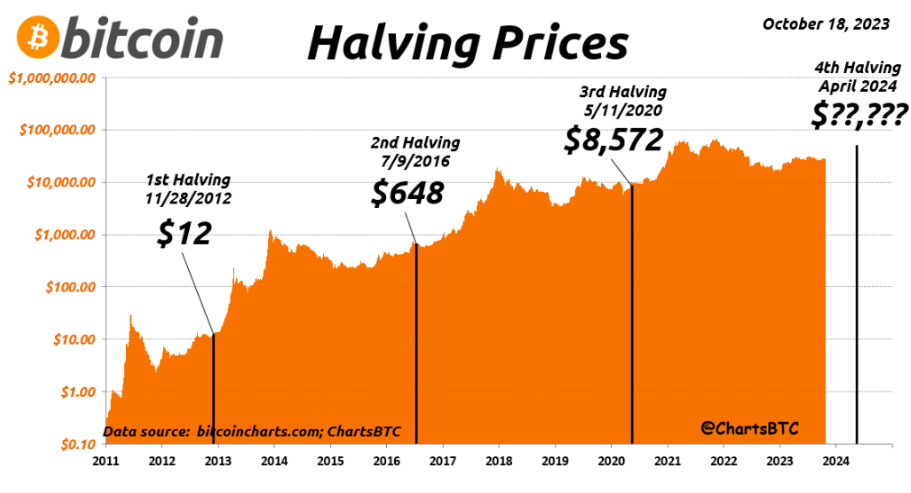บทความ
ปรากฏการณ์ Bitcoin Halving คืออะไร?

สำหรับวงการคริปโทเคอร์เรนซี ทุก ๆ 4 ปี จะมีปรากฏการณ์สำคัญเกิดขึ้น นั่นคือ Bitcoin Halving ในบทความนี้ เราจะมาทำความเข้าใจว่า Bitcoin Halving คืออะไร ทำไมจึงเกิดขึ้นทุก ๆ 4 ปี และส่งผลเช่นไรกับตลาด?
ติดตาม Bitcoin Halving Countdown ได้ที่นี่: http://bitkub.com/halving
หลักการทำงานของ Bitcoin
Bitcoin มีเทคโนโลยีเบื้องหลังที่ใช้สำหรับการบันทึกธุรกรรมเรียกว่า Blockchain
Blockchain คือฐานข้อมูล (Database) รูปแบบหนึ่ง แต่แทนที่จะเก็บข้อมูลทุกอย่างไว้บนเครื่องคอมพิวเตอร์เพียงเครื่องเดียว Blockchain จะเก็บข้อมูลไว้บนเครื่องคอมพิวเตอร์ของผู้ใช้นับล้านเครื่องทั่วโลก โดยทุกเครื่องจะเก็บข้อมูลชุดเดียวกันและมีการตรวจสอบข้อมูลตรงกันเสมอ
ทีนี้ ถ้าเกิดว่ามีข้อมูลหรือธุรกรรมชุดใหม่ที่ต้องบันทึกเพิ่มลงไป ทำอย่างไรเครือข่ายถึงจะเห็นตรงกันว่าข้อมูลธุรกรรมนั้นถูกต้อง โดยที่ไม่ต้องรู้จักกัน?
Blockchain ของ Bitcoin ใช้ระบบที่เรียกว่า Proof-of-Work ในการตรวจสอบความถูกต้องของธุรกรรมและทำให้ผู้ใช้ในเครือข่ายยอมรับความถูกต้องของธุรกรรมนั้น ๆ ได้
ระบบ Proof-of-Work คือการที่เครื่องคอมพิวเตอร์ในเครือข่ายจะต้อง “แข่งกัน” แก้ไขสมการทางคณิตศาสตร์ แลกกับสิทธิ์ในการรับรองธุรกรรมและเพิ่มข้อมูลชุดใหม่ หรือที่เรียกว่าการเพิ่มบล็อกใหม่ ลงไปใน Blockchain กระบวนการนี้เรียกว่า “การขุด”
เมื่อมีผู้ใช้ที่สามารถแก้ไขสมการได้เป็นคนแรก ผู้ใช้คนนั้นจะสามารถเซ็นรับรองธุรกรรมและเพิ่มธุรกรรมชุดนั้นลงไปในบล็อกใหม่ จากนั้นผู้ใช้คนอื่นก็จะเข้ามาช่วยเซ็นรับรองธุรกรรมนั้นอีกที ผู้ที่สามารถแก้ไขสมการได้เป็นคนแรกก็จะได้รับรางวัลเป็น Bitcoin เหรียญใหม่ที่ยังไม่ออกมาในระบบ เรียกว่า “รางวัลจากการขุด”
Bitcoin Halving คืออะไร?
ในช่วงแรกที่ Bitcoin เกิดขึ้นมา จำนวน Bitcoin ที่จะได้รับหากแก้สมการสำเร็จเป็นคนแรกอยู่ที่ 50 เหรียญต่อบล็อก แต่ Satoshi Nakamoto ผู้สร้าง Bitcoin ได้ฝังชุดคำสั่งไว้ใน Blockchain ที่กำหนดให้รางวัลจากขุดจะลดลง “ครึ่งหนึ่ง” ทุก ๆ 210,000 บล็อก แต่ละบล็อกจะถูกสร้างขึ้นทุก 10 นาที ดังนั้น 210,000 บล็อก จะใช้เวลาโดยประมาณ 4 ปี
การที่รางวัลจากการขุดจะลดลงทุก ๆ 4 ปี เรียกกันว่าปรากฏการณ์ Bitcoin Halving นับตั้งแต่ที่ Bitcoin เกิดขึ้นมาบนโลก เกิด Bitcoin Halving มาแล้ว 3 ครั้ง
-ครั้งที่ 1) ในปี 2012 รางวัลลดลงจาก 50 เหรียญ เหลือ 25 เหรียญ
-ครั้งที่ 2) ในปี 2016 ลดลงจาก 25 เหรียญ เหลือ 12.5 เหรียญ
-ครั้งที่ 3) เกิดขึ้นเมื่อวันที่ 11 พฤษภาคม ปี 2020 ลดลงจาก 12.5 เหรียญ เหลือ 6.25 เหรียญ
สำหรับวันที่คาดการณ์ว่าจะเกิดปรากฏการณ์ Halving ครั้งต่อไปคือประมาณ วันที่ 20 เมษายน 2024 (เวลาอาจมีการเปลี่ยนแปลงได้) โดยรางวัลจะลดลงจาก 6.25 เหรียญ เหลือ 3.125 เหรียญ

นอกจากนี้ Bitcoin ยังถูกสร้างขึ้นมาให้มีจำนวนสูงสุดได้ที่ 21,000,000 เหรียญ โดยเมื่อพิจารณาจากการ Halving แล้ว คาดว่าทั้ง 21 ล้านเหรียญจะถูกขุดออกมาครบภายในปี 2140 หรืออีกประมาณ 120 ปีข้างหน้า
ผลกระทบของ Bitcoin Halving
การที่รางวัลจากการขุด Bitcoin ลดลงทุก ๆ 4 ปี หมายความว่า อุปทาน (Supply) ของ Bitcoin ที่ค่อนข้างจำกัดอยู่แล้ว จะยิ่งจำกัดลงไปอีก
ในขณะที่อุปสงค์ (Demand) ใน Bitcoin กลับเพิ่มขึ้นเรื่อย ๆ เห็นได้จากข่าวที่บริษัทต่าง ๆ พากันเข้าซื้อ Bitcoin ไม่ว่าจะเป็น Tesla, MicroStrategy, Square รวมถึงธนาคารระดับโลกที่เริ่มสนใจ Bitcoin เช่นกัน ไม่ว่าจะเป็น Goldman Sach, หรือ Morgan Stanley เป็นต้น

ท่ามกลางสภาวะที่อุปทานของ Bitcoin ลดน้อยลง ขณะที่อุปสงค์กลับเพิ่มขึ้นเรื่อย ๆ ตามทฤษฎีแล้ว ราคาของ Bitcoin จะมีแนวโน้มเพิ่มสูงขึ้นทุกครั้งที่เกิดปรากฏการณ์ Bitcoin Halving ตามภาพประกอบด้านบน โดยเส้นสีฟ้าคือช่วงที่เกิด Bitcoin Halving
อย่างไรก็ตาม นี่เป็นเพียงการคาดการณ์ โดยวิเคราะห์จากข้อมูลในอดีตเท่านั้น ไม่สามารถรับรองได้ว่าราคา Bitcoin จะปรับขึ้นอีกหลัง Bitcoin Halving ครั้งต่อไป นักลงทุนควรมีวิจารณญาณ และบริหารความเสี่ยงให้เหมาะสม โดยแนะนำใช้เงินเย็นเข้ามาลงทุน และศึกษาทำความเข้าใจสินทรัพย์ที่จะลงทุนให้ละเอียด
อ้างอิง Investopedia, BuyBitcoinWorldwide, Coinmarketcap
(บทความนี้เผยแพร่ครั้งแรกเมื่อวันที่ 2 มิถุนายน 2021 / แก้ไขล่าสุดเมื่อวันที่ 19 เมษายน 2024)
===================
บทความที่คุณอาจสนใจ
-ทำความเข้าใจ Bitcoin คืออะไร? ภายใน 3 นาที
-ตอบทุกคำถามว่าการขุด Bitcoin คืออะไร ?
-มาย้อนดูการเติบโตของ Bitcoin ตลอด 13 ปีที่ผ่านมากันเถอะ!
===================
คำเตือน
*สินทรัพย์ดิจิทัลมีความเสี่ยง โปรดศึกษาและลงทุนให้เหมาะสมกับระดับความเสี่ยงที่ยอมรับได้
**คริปโทเคอร์เรนซีมีความเสี่ยงสูง คุณอาจสูญเสียเงินลงทุนได้ทั้งจํานวน
***ผลตอบแทนของสินทรัพย์ดิจิทัลในอดีตหรือผลการดําเนินงานในอดีต มิได้เป็นสิ่งยืนยันถึงผลตอบแทนของสินทรัพย์ดิจิทัลหรือผลการดําเนินงานในอนาคต
===================
Get to know about Bitcoin Halving

For the cryptocurrency industry, there is a significant event that occurs every 4 years called Bitcoin Halving. In this article, we will understand what Bitcoin Halving is, why it happens every 4 years, and what impact it has on the market.
Follow this link for Bitcoin Halving Countdown
How does Bitcoin Work?
Bitcoin has an underlying technology used for recording transactions called Blockchain.
Blockchain is a type of database, but instead of storing all data on one computer, it stores data on millions of computers worldwide. Each computer stores the same data and there is constant verification of the data.
Now, if there is new data or a new transaction that needs to be added, how does the network know that the data is correct without knowing each other?
The Bitcoin blockchain uses a system called Proof-of-Work to verify the correctness of transactions and make sure that users in the network accept the correctness of the transaction.
Proof-of-Work is a process where computers in the network compete to solve mathematical equations to earn the right to certify transactions and add new data, called “mining,” to the blockchain.
When a user is the first to solve the equation, they can sign the transaction and add it to a new block. Then other users can come in and certify the transaction again. The first user to solve the equation receives a reward in the form of a newly created Bitcoin, called a “mining reward”.
What is Bitcoin Halving?
In the early days of Bitcoin, the reward for solving the equation and being the first to create a block was 50 coins. However, Satoshi Nakamoto, the creator of Bitcoin, embedded a set of commands in the blockchain that would decrease the mining reward by “half” every 210,000 blocks. Each block is created every 10 minutes, so 210,000 blocks take approximately 4 years to mine.
The phenomenon of the mining reward decreasing every 4 years is known as Bitcoin Halving. Since the inception of Bitcoin, there have been 3 Bitcoin Halvings.
The first Bitcoin Halving occurred in 2012, when the reward was reduced from 50 to 25 coins. The second Halving occurred in 2016, when the reward was reduced from 25 to 12.5 coins. The most recent Halving occurred on May 11, 2020, when the reward was reduced from 12.5 to 6.25 coins.
The next Bitcoin Halving is predicted to occur on approximately April 20, 2024 (time is subject to change), when the reward will be reduced from 6.25 to 3.125 coins.
Furthermore, Bitcoin is designed to have a maximum supply of 21 million coins. After taking the halving into account, it is estimated that all 21 million coins will be mined by the year 2140, or in another 120 years.
The Impact of Bitcoin Halving
The fact that the reward for mining Bitcoin decreases every 4 years means that the supply of Bitcoin, which is already relatively limited, will be even more limited.
While the demand for Bitcoin continues to increase, as evidenced by news of various companies such as Tesla, MicroStrategy, and Square buying Bitcoin, as well as global banks showing interest in Bitcoin such as Goldman Sachs and Morgan Stanley.

Amidst the situation where the supply of Bitcoin is decreasing while the demand is increasing, according to theory, the price of Bitcoin tends to increase every time Bitcoin Halving occurs, as shown in the above chart, with the blue line representing the period of Bitcoin Halving.
However, this is just a prediction based on past data analysis, and it cannot be guaranteed that the price of Bitcoin will increase again after the next Bitcoin Halving. Investors should exercise caution and manage risk appropriately, by using disposable income for investment and thoroughly studying the assets they plan to invest in.
References: Investopedia, BuyBitcoinWorldwide, Coinmarketcap
Disclaimer:
-Cryptocurrency is highly risky; investors may lose all investment money.
-Digital assets involve risks; investors should study information carefully and make investments according to own risk profile.
-Returns/Past Performance does not guarantee future returns/performance.
ที่มา:
Medium